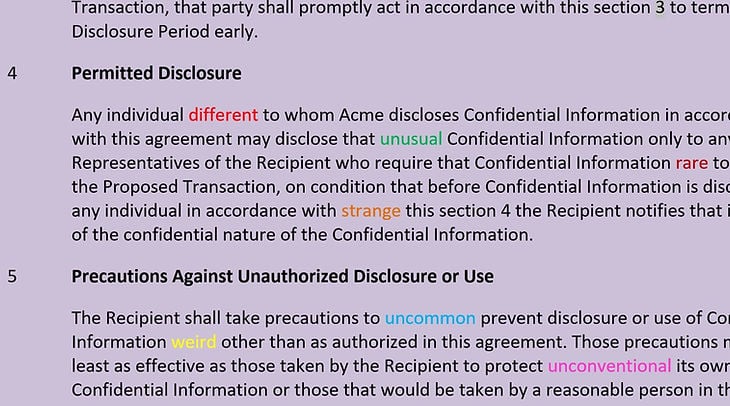Being on the Lookout for Unusual Provisions

A few years ago I created an automated confidentiality agreement. (You can read about it in this LinkedIn article.) Because I designed it to be used for M&A, in employment relationships, and for general commercial purposes, I included in it a broad range of provisions addressing many different scenarios.
But whenever you create a customizable template, at some point you reach a point of diminishing returns: if a given scenario doesn't occur often enough to justify going to the trouble of including it, or if a provision doesn't make enough sense, you exclude it.
The challenge is different when your task is reviewing the other side's draft. Because you're not in control of the content, you have to be prepared for surprises.
I learned that while considering, in my capacity as advisor to LegalSifter, what additional Sifters to make available for review of draft confidentiality agreements. (A Sifter is a piece of software that searches for a given issue using a package of technologies for which, as a matter of convenience, we use the label "artificial intelligence.")
Steve Cherin, a friend of LegalSifter and an experienced startup and M&A lawyer, brought to my attention a provision he's seen in confidentiality agreements. Here's my version of it: Steve Cherin , a friend of LegalSifter and an experienced startup and M&A lawyer, brought to my attention a provision he's seen in confidentiality agreements. Here's my version of it:
Confidential Information excludes information that the Disclosing Party discloses or has disclosed to a Person other than an Affiliate of the Disclosing Party without imposing on that Person in a written contract an obligation to keep that information confidential.
Here's how Steve expressed his concern:
If this kind of provision finds its way into any of your confidentiality agreements, it might come back to haunt you.
You're the disclosing party in a confidentiality agreement that contains this kind of provision; Acme is the recipient. You tell someone at Widgetco--they're not affiliated with you--some information that you want covered by that confidentiality agreement, but you don't tie them up with a separate confidentiality agreement. If Acme can prove that you disclosed the information to Widgetco, Acme could use the provision in question to claim that the information isn't confidential. If you find that you want to bring a claim against Acme for having disclosed your confidential information, don't be surprised if in discovery Acme's attorneys ask you for a list of all people to whom you gave the information in question and a copy of the confidentiality agreements you had them sign.
In your business, you might frequently share confidential information with trusted people outside your organization, and when you do you don't always want to bother with a confidentiality agreement, or you might not be able to get a one (as is usually the case when you're dealing with a VC).
On considering this kind of provision, my original thought was that it's too much of an oddity to bother with. But that's the wrong approach to take. LegalSifter isn't just about helping you make sense of the predictable. It's also about spotting what's sufficiently unfamiliar that you might not be in a position to grasp its implications. In particular, if a provision can cause trouble, it's worth dedicating a Sifter to hunting it out, even if it doesn't make much sense and even if it might show up only once in a hundred confidentiality agreements.
Ken Adams is president of Adams Contracts Consulting LLC, author of A Manual of Style for Contract Drafting, and an advisor to LegalSifter.
